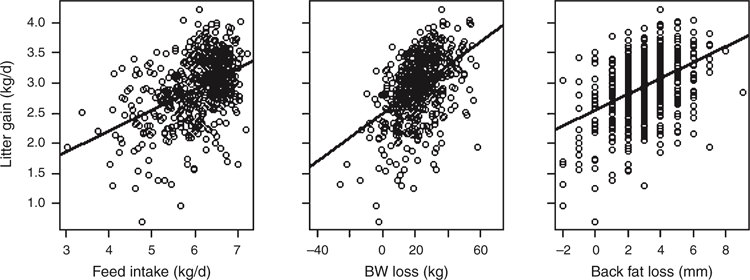Sows with high milk production had a high feed intake and high body mobilisation
A. V. Strathe A , T. S. Bruun B and C. F. Hansen A CA University of Copenhagen, Copenhagen, Denmark.
B Danish Pig Research Centre, SEGES P/S, Copenhagen, Denmark.
C Corresponding author. Email: cfh@sund.ku.dk
Animal Production Science 55(12) 1479-1479 https://doi.org/10.1071/ANv55n12Ab065
Published: 11 November 2015
The modern high-producing sow has undergone major genetic improvements during the last decades resulting in larger and leaner animals and larger litter sizes. Milk production is affected positively by feed intake during lactation (Vadmand et al. 2015), but many sows turn catabolic during the lactation period to maintain their milk production, because they are unable to increase the feed intake at the same rate as milk production is increasing (Hansen et al. 2012). It was hypothesised that sows having the highest litter gains during lactation would stand out from other sows when comparing feed intake, body mobilisation during lactation and the subsequent reproduction.
The data for the current evaluation was obtained from a nutritional study of the effects of increasing dietary valine-to-lysine ratio on the performance of litters and sows during lactation. There were no effects (P > 0.30) of the dietary treatments on any of the measured parameters (Strathe et al. 2015) and therefore the data were pooled for this evaluation. The data from 565 sows (parity 2.5 ± 1.0; mean ± SD), where litters had been standardised to 14 piglets at d 2 post-partum and piglets were weaned at d 26, were used in the analysis. Sow body weight (BW), backfat thickness (BF) and litter weight were registered for all sows at d 2 and at weaning. Milk yield was calculated using equations by Hansen et al. (2012). Pearson’s correlations (R Core Team, Austria) were calculated to test for correlations between the measured variables.
On average, the sows weaned 13.0 ± 1.1 piglets (mean ± SD), had a litter gain of 2.9 ± 0.5 kg/d and had an estimated milk yield of 11.3 ± 1.4 kg/d. The feed intake of the sows was 6.1 ± 0.7 kg/d and the sows lost 22.5 ± 12.7 kg BW (9.1 ± 5.1% of their BW at d 2) and 2.9 ± 1.7 mm BF from d 2 post-partum until weaning. The weaning-to-estrus interval (WEI) was 5.3 ± 6.1 days and in the next litter, the sows gave birth to 18.2 ± 3.8 total born piglets. Feed intake (r = 0.46, P < 0.001), BF loss (r = 0.42, P < 0.001) and BW loss (r = 0.48, P < 0.001) during lactation had a positive effect on litter gain (Fig. 1). Increasing feed intake in lactation reduced the WEI (r = –0.16, P < 0.001) and increased total born piglets in next litter (r = 0.14, P < 0.01), but BW loss only had an effect on total born piglets in next litter (r = –0.10, P < 0.05) and no effect on WEI (r = –0.04, P = 0.30) (Fig. 1).

|
Increasing average daily feed intake during lactation with 1 kg improved daily litter gain by 340 g [Litter gain (kg/d) = 0.85 + 0.340 × Feed intake (kg/d)]. A sow BW loss of 1 kg heightened daily litter gain with 20 g [Litter gain (kg/d) = 2.48 + 0.020 × BW loss (kg)], whereas a BF loss of 1 mm enhanced litter gain with 130 g/d [Litter gain (kg/d) = 2.55 + 0.130 × BF loss (mm)]. In conclusion sows with high litter gains both had a high feed intake and BW loss during lactation, but the high body mobilisation had a negative effect on the size of the next litter.
References
Hansen AV, Strathe AB, Kebreab E, France J, Theil PK (2012) Journal of Animal Science 90, 2285–2298.| Crossref | GoogleScholarGoogle Scholar |
Strathe AV, Bruun TS, Hansen CF (2015) APSA Manipulating Pig Production XV, 54, eds JR Pluske and JM Pluske.
Vadmand CN, Krogh U, Hansen CF, Theil PK (2015) Journal of Animal Science 93, 2488–2500.
| Crossref | GoogleScholarGoogle Scholar |


